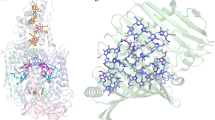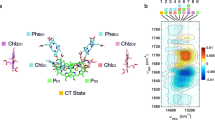Abstract
The key steps in the photosynthetic conversion of light to chemical potential energy include not only photodriven charge separation, but also prevention of the back-reaction (charge recombination). Although the first of these steps has been achieved in several biomimetic solar energy conversion systems, retarding the back-reaction has proved more difficult. This may be accomplished by rapidly moving the electron, the hole, or both away from the site of excitation to more stabilizing environments. In photosynthetic membranes, the electron is transferred sequentially over several closely coupled molecules, including tetrapyrroles and quinones1–3. In semiconductor/liquid interfacial systems both the electron and the hole migrate following excitation4,5. We now report that substantial slowing of the back-reaction has been achieved with a tripartite molecule in which a long-lived photodriven charge-separated state of relatively high potential is formed from an excited singlet state in accordance with the above principles. This molecular triad (compound I) consists of a tetraarylporphyrin covalently linked to both a carotenoid and a quinone. In solution, excitation of the porphyrin moiety by visible light results in the rapid (<100 ps) formation of a transient species C+.−P−Q−−., with a lifetime on the μs time scale and an energy more than 1 eV above the ground state.
Similar content being viewed by others
References
Dutton, P. L., Prince, R. C. & Tiede, D. M. Photochem. Photobiol. 28, 939–949 (1978).
Sauer, K. Acc. chem. Res. 11, 257–264 (1978).
Mathis, P. & Paillotin, G. in The Biochemistry of Plants Vol. 8 (eds Hatch, M. D. & Boardman, N. K.) 97–161 (Academic, New York, 1981).
Gerischer, H. in Topics appl. Phys. 31, 115–172 (1979).
Wrighton, M. S. Acc. chem. Res. 12, 303–310 (1979).
Dirks, G., Moore, A. L., Moore, T. A. & Gust, D. Photochem. Photobiol. 32, 277–280 (1980).
Moore, A. L., Dirks, G., Gust, D. & Moore, T. A. Photochem. Photobiol. 32, 691–695 (1980).
Bensasson, R. V. et al. Nature 290, 329–332 (1981).
Moore, A. L. et al. Science 216, 982–984 (1982).
Liddell, P. A. et al. Photochem. Photobiol. 36, 641–645 (1982).
Chachaty, C. et al. Org. magn. Reson. (in the press).
van Best, J. A. & Mathis, P. Rev. scient. Instrum. 49, 1332–1335 (1978).
Keene, J. P. J. scient. Instrum. 41, 493–496 (1964).
Dorfman, L. M., Sujdak, R. J. & Bockrath, B. Acc. chem. Res. 9, 352–357 (1976).
Mathis, P. & Vermeglio, A. Photochem. Photobiol. 15, 157–164 (1972).
Dawe, E. A. & Land, E. J. JCS Faraday Trans. I 71, 2162–2169 (1975).
Chauvet, J. -P., Viovy, R., Land, E. J., Santus, R. & Truscott, T. G. J. phys. Chem. 87, 592–601 (1983).
Mialocq, J. C. Chem. Phys. 73, 107–115 (1982).
Migita, M. et al. Chem. Phys. Lett. 84, 263–266 (1981).
Bergkamp, M. A., Dalton, J. & Netzel, T. L. J. Am. chem. Soc. 104, 253–259 (1982).
Bensasson, R. & Land, E. J. Photochem. photobiol. Rev. 3, 163–191 (1978).
Moore, T. Benin, D. & Tom, R. J. Am. chem. Soc. 104, 7356–7357 (1982).
Kong, J. L. Y., Spears, K. G. & Loach, P. A. Photochem. Photobiol. 35, 545–553 (1982).
Tabushi, I., Koga, N. & Yanagita, M. Tetrahedron Lett. 257–260 (1979).
Ho, T. F., Mclntosh, A. R. & Bolton, J. R. Nature 286, 254–256 (1980).
Mulliken, R. S. J. Am. chem. Soc. 72, 600–608 (1950); 74, 811–824 (1952).
Schenck, C. C., Diner, B., Mathis, P. & Satoh, K. Biochim. biophys. Acta 680, 216–227 (1982).
Paramonova, L. I., Naush, Ya., Kreslavskii, V. D. & Stolovitskii, Yu. M. Biophysics 27, 199–203 (1982).
Prince, R. C., Gunner, M. R. & Dutton, P. L. in Function of Quinones in Energy Conserving Systems (ed. Trumpower, B. L.) 29–33 (Academic, New York, 1982).
Platt, J. R. Science 129, 372–374 (1959).
Mauzerall, D. Israel J. Chem. 21, 321–324 (1981).
Mialocq, J. C., Amouyal, E., Bernas, A. & Grand, D. J. phys. Chem. 86, 3173–3177 (1982).
Author information
Authors and Affiliations
Rights and permissions
About this article
Cite this article
Moore, T., Gust, D., Mathis, P. et al. Photodriven charge separation in a carotenoporphyrin–quinone triad. Nature 307, 630–632 (1984). https://doi.org/10.1038/307630a0
Received:
Accepted:
Issue Date:
DOI: https://doi.org/10.1038/307630a0
- Springer Nature Limited
This article is cited by
-
Pushing the limits of flash photolysis to unravel the secrets of biological electron and proton transfer
Photochemical & Photobiological Sciences (2022)
-
Self-assembled molecular p/n junctions for applications in dye-sensitized solar energy conversion
Nature Chemistry (2016)
-
Evolution of reaction center mimics to systems capable of generating solar fuel
Photosynthesis Research (2014)
-
Design of synthetic molecular units including quinones towards the construction of artificial photosynthesis
Research on Chemical Intermediates (2014)





